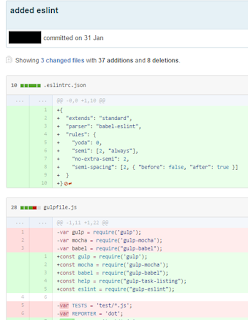For almost one semester now, I have been working on two open-source projects that are quite different in nature. The first one is an open-source project being used by developers who wanted to use WebSocket in their web application, and maintained by a handful of developers from different parts of the world; Socket.IO. The other one is also an open-source project, but it is being developed mainly by students (and a large number of them in certain period), and with lesser variety (and probably quantity as well) of users; PowerPointLabs.
Organization
Being school-based project, I found PowerPointLabs to be more organized in the way it writes the guide for contributing. This does not come as a surprise, as most of the developers are actually students who have little or no prior experience contributing to an open-source project. In contrast, guide for contributing to Socket.IO is practically non-existent; the only guide they provided in the website is the guide on how to use the Socket.IO itself, not how to contribute to it. This is also very normal because being a library, most developers who visit the website/Github page are probably intending to use the library instead of contributing to it.
Also, getting Pull Requests to be merged into school-based open-source project is somewhat more difficult than getting the same done in external projects. This is because for the school-based one, strict review is carried out to instil good coding practice to the students. On the other hand, most open-source project out there are not very particular about coding practice, as long as it is not detrimental to the functionalities of the project. Moreover, most people who contributed to crucial parts of the project are most probably experienced developers anyway so there is no need to have such a strict review system. If the project owner/maintainer is particular about certain coding standards, he/she can always incorporate linting to the project (which is what I did for the course).
Ease of Contributing
Ease of contributing is not quite the same as ease of getting pull request to be merged; ease of contributing here refers to having something to contribute upon in the first place.
Contributing to internal open-source projects are easy. This is because the projects are there with exactly that purpose; for students to contribute to it.
Contributing to external open-source projects are much more difficult as most of such projects are already mature. Usually contributions from external developers (not the project's core team) is in the form of bugfixes, which is arguably more difficult to do than implementing new features for internal projects. This is because the developers of the external open-source projects are usually experienced developers and thus bugs in their code are usually mistakes that can not be easily fixed.
This is in contrast to internal projects where non-critical bugs are left on purpose so that the students can familiarize themselves with the code base; there is no such a thing in external open-source projects.
Rate of Development
Most open-source projects out there usually have a relatively longer release cycle compared to school-based open-source projects. This is because most open-source project contributors have full-time jobs or other commitments, and thus cannot afford to work on the open-source project full time. This sometimes results in long outstanding pull requests (especially if it is not a critical bugfix). Also, the project's main developers come from different parts of the world, and thus the different time zones the different developers live in may impact the rate of development as different developers are awake on different timings.
On the other hand, students may be considered as working on the project full-time and thus the release cycle tends to be much shorter, and I have yet to encounter an unattended long, outstanding pull request in PowerPointLabs or any other NUS projects unless if it is the student sending the pull request ignoring the feedback from the core developer team.
Suggestions for Improvement
There is always a room for improvements, be it for the internal school-based projects or the external ones.
For the external projects, it may be good to have more than one person to be in-charge of a project so as to prevent long outstanding pull request if the person in-charge is busy with other commitments. This is especially important if the project is listed on university programmes such as Facebook Open Academy or Google Summer of Code, when the rate of development will increase tremendously due to the extra manpower during the period.
For the internal projects, I feel that there is not much suggestion I can provide in terms of workflow; I think the current workflow works well to serve its purpose. However, I have the feeling that school-based projects have features that is not very well-polished. It could be better to focus the effort on polishing existing features first before implementing new ones. I think doing a product that do a few things but doing it well is better than a product that can do a lot of things but not good at any of it.
Conclusion and Closing
In conclusion, I think internal (school-based) open-source projects are much more organized in terms of contribution guide, are easier to contribute to, and are faster in release cycle than external open-source projects. External projects can do better by having multiple people in charge of the development so that they can fill in the other person if he/she is busy with other commitments. Internal projects may try to focus more on polishing existing features, which I think is the better approach, instead of keep releasing new features.



